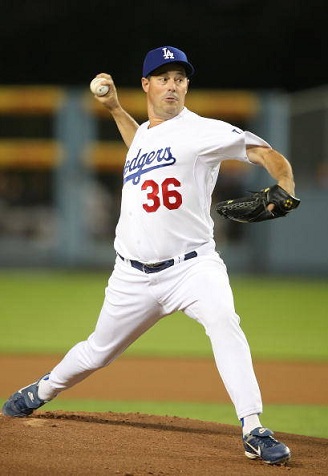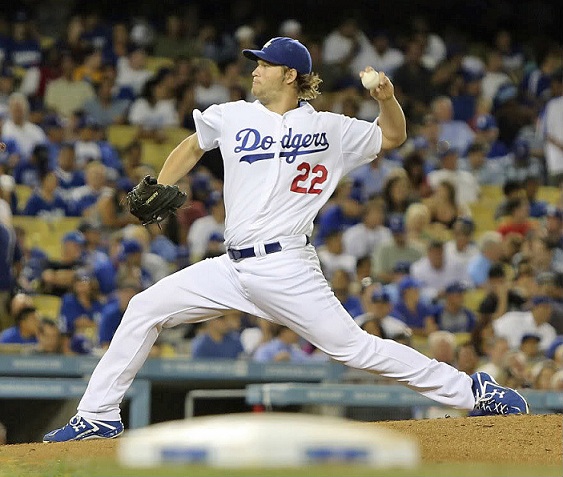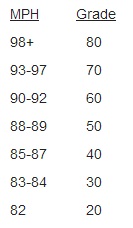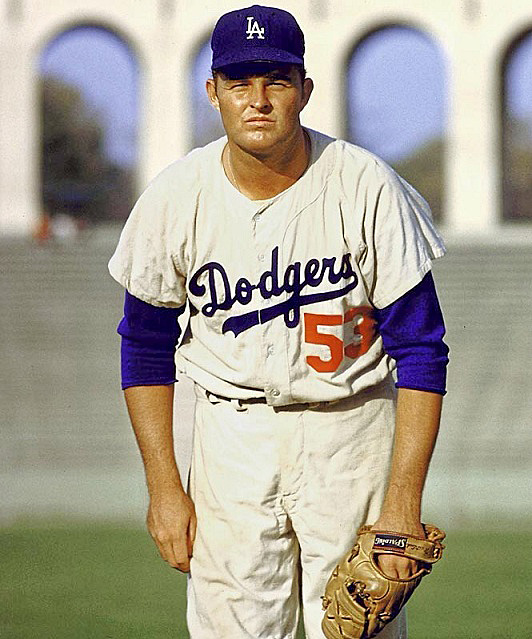One of the most ambiguous terms in all of baseball is the word “ace,” as in staff ace. It is a word that gets tossed around as casually (and sometimes as carelessly) as the words “superstar” or “heart.”
But what exactly is an ace? Is it simply the guy who gets the Opening Day nod, or the guy who had the best record or the lowest ERA or most strikeouts last season? Would an ace on the Astros be considered an ace on the Dodgers or Phillies or Giants, or would they merely be a number 3, 4 or 5 starter on those other teams?
And there’s another question – what determines what a 3, 4 or 5 starter is?
To the casual fan, questions like these usually boil down to who they like best – for example: I like Kershaw better than Greinke and Greinke better than Ryu and Ryu better than Billingsley and Billingsley better than Capuano – thus, I have my 1 through 5 starting rotation set.
The truth of the matter is that it doesn’t work this way in professional baseball, not even close. While our affection for particular pitchers may determine how we think the starting rotation should be set, managers and general managers have an entirely different criteria – one that is based on a specific yet simple sabermetric formula used by nearly every team in Major League Baseball these days.
Now before you run off telling everyone that I’ve lost my mind or that I don’t have a clue about what I am talking about here, let me confirm with you that I actually didn’t have a clue about this stuff until I sat down and researched it. No, I don’t have a subscription to Popular Sabermetrics (I made that up) or anything of the sort; I simply did what any red-blooded American with these types of questions (and a computer) would do… I Googled it.
Before we get into the ace and the 1 through 5 thing, there are two terms that need to be defined. They are the terms “plus” and “plus-plus,” which are frequently used by general managers and scouting people when describing a player’s skill level. Scouts use a very specific grading system to evaluate all players, and in a pitcher’s case, to evaluate each of their pitches. This grading system isn’t your typical 1 to 10 scale used to rate movies or the 1 through 5 stars used to rate restaurants and hotels. Instead, scouts use a 20 through 80 scale in increments of 5. As you might expect, a 50 on this scale is considered a major league average, with 20 at the low end and 80 at the high end or elite status (neither extreme is used very often). A “plus” is an above-average rating (a 60 on the scale) and a “plus-plus” is a well above average rating (a 70 on the scale). An 80 speaks for itself.
As I said, each of a pitcher’s individual pitches are evaluated using this grading system. Let’s use a pitcher’s fastball as an example, more specifically, the velocity of their fastball. Here is how a scout might grade a pitcher’s fastball velocity:
This same rating system is used for each pitch in a pitcher’s arsenal. When all of these numbers are put together and are compared with all of the other pitchers on the staff, you begin to see how it all comes together and how pitching rotations are determined. The end result might look something like this:
- #1 Starter – Two plus pitches, average third pitch, plus-plus command, plus makeup
- #2 Starter – Two plus pitches, average third pitch, average command, average makeup
- #3 Starter – One plus pitch, two average pitches, average command, average makeup
- #4 & #5 Starters – Average velocity, consistent breaking ball, decent change-up, command of two of the pitches
- Closer – One dominant pitch, second plus pitch, plus command, plus-plus makeup
Although the 1st and 2nd starters have the exact same pitches, they differ in command and makeup. A pitcher’s makeup includes his character, focus, intensity, intimidation, etc. The 3rd starter is the same as the 2nd starter except one of his plus pitches drops to average, and the 4th and 5th starters are pretty much average across the board.
When you look at a guy like next year’s first ballot Hall of Famer Greg Maddux (and you can take that to the bank), it is a well known fact that his fastball was anything but average, however; he had a plus curveball and a plus-plus change-up with outstanding command and tremendous makeup. Because he excelled in every other category, he was extremely successful even without an above-average fastball – but there aren’t many others with this kind of talent; in fact, I can’t name one.

Even near the end of his career, future Hall of Famer Greg Maddux still had ace-like stuff, in spite of his 80 MPH fastball.
(Photo credit – Lisa Blumenfeld)
As for the ace thing – using the above system, if a number 1 starter adds one or two plus-plus ratings to his overall rating, I think it’s safe to say that you have an ace on your staff, say… like Clayton Kershaw, who I would rate as plus-plus in every category.
So, Mr. GM (or you Gus Lobel /Clint Eastwood types) – using the same rating system that Stan Kasten, Ned Colletti and Don Mattingly are using, how would you set the Dodgers rotation at this point in time?




 January 27th, 2013 at 5:54 am
January 27th, 2013 at 5:54 am  by Ron Cervenka
by Ron Cervenka 



 Posted in
Posted in 

Gee 53, you’re really going out on a limb with that Maddux prediction, don’t you think? 🙂
At this point, without taking into consideration the physical health of the pitchers, I’d set the Dodgers rotation as follows:
1 – Clayton Kershaw
2 – Zach Grienke
3 – Chad Billingsley
4 – Hyun-jin Ryu
5 – Josh Beckett
As for this thread; I’d give it a PLUS. But that photo of Drysdale posing on the mound in front of the LA Coliseum peristyle is definitely PLUS – PLUS.
Yah, what he said, but Ryu is a big question mark until we see how he does in Glendale next month into March.
I’m more concerned about Billingsley than I am about Ryu. Have you seen this kid? He’s HUGE! His nickname is “Monster.” I think you will all be pleasantly surprised with him.
Speaking of Maddux – it’s been a long time since I thought anyone deserved 100% votes but he is the one. Of course, some a-h that votes will not think anyone is perfect. He was as close to perfect as we’ve seen in a long, long time.
Ryu is still an unknown to me. I would go with:
1. Kershaw
2. Grienke
3. Billingsley
4. Beckett
5. Capuano
Read this possible scenario today.
Chris Capuano gets traded. (most of us suspect to the Mariners)
Chad Billingsley starts the season on the DL. We expect it to happen in 2013 (TJ surgery) so sooner is better than later
Ted Lilly becomes an in house lefty specialist reliever to limit his innings.
Rotation: CK
Greinke
Beckett
Ryu
Harang
Doesn’t look as good without Capuano and Billingsley.
I would much rather see Harang go then Capuano, in fact I would think Capuano would be untouchable until we know more about Bills !! IMO better to let Harang go for little in return then trade Capuano for something more.
I am not proposing that Gary – would sooner have Capuano than Harang – but Capuano is more tradeable.
Not that it would happen, but Harang can be DFA’d as far as I’m concerned. Shouldn’t matter who’s more tradeable, should only matter who’s better in our rotation.
I absolutely do not get where you are coming from with Harang, Gary. He pitched exactly as he was expected to: .500 (10-10) with an ERA of 3.61 (Capuano’s was 3.72). They both should have had 3 or 4 more wins, but got little run support.
If you use the above guide, both Harang and Capuano would be rated as #4 and #5 guys, which is exactly what they were signed to be. Capuano may be a #3 because he is a lefty with a plus curve ball.
The Dodgers would be foolish to DFA Harang because there are teams out there that could desperately use him, so why not trade him instead? It would also be foolish to DFA him because the Dodgers still owe him $7M for 2013 with an option for 2014. I’m a lot more comfortable with him on the hill than Ted Lilly, that’s for sure.
Gary, you sure you meant Harang? As Ron points out, Harang was not useless, and he’s a great clubhouse guy. He’d make a great middle/long relief man should the team hang onto him. Any other team and he’d be a number 4 or 5 guy…
…but agreed that the team would be better served with Capuano in the starting rotation if Billingsley can’t answer the bell.
Kevin, I was only comparing Harang vs Capuano and only on starting not in relief. Fact is I would ship Lilly out before Harang and if Harang were to accept a relief role I would seriously consider it. But my choice would be for Capuano as our #5